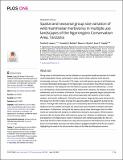| dc.description.abstract | Group sizes of wild herbivores can be indicators of ecosystem health and proxies for individual and population fitness, particularly in areas where human activities have become increasingly common. We recorded 176 single- and multi-species groups of wild herbivores in human-dominated landscapes of the Ngorongoro Conservation Area (NCA) during dry and wet seasons. We analyzed how wild herbivore group sizes were affected by: (1) season, (2) distance to fully protected area (NCA crater) and to streams, (3) distance to human settlements, and (4) numbers of livestock. Group sizes were generally larger during the wet season than during the dry season and varied seasonally with distance to NCA crater, streams, and human settlements. During the wet season, larger groups were observed further away from the NCA crater whereas the opposite pattern was apparent during the dry season. Average wild herbivore group sizes increased by about three-fold with increasing distance from the streams during the dry season but were invariant to streams during the wet season. Furthermore, during the dry season, group sizes were larger close to settlements but varied little with distance to settlements during the wet season. While livestock presence did not directly affect wild herbivore group size, distance to settlements, streams and distance to the Ngorongoro crater in interaction with rainfall seasonality did. We conclude that the NCA crater functions as a key resource area for wild herbivores such as wildebeest (Connochaetes taurinus) and zebra (Equus quagga burchelli) during the dry season, highlighting the need for its full protection status in this Man and Biosphere reserve. | en_US |

